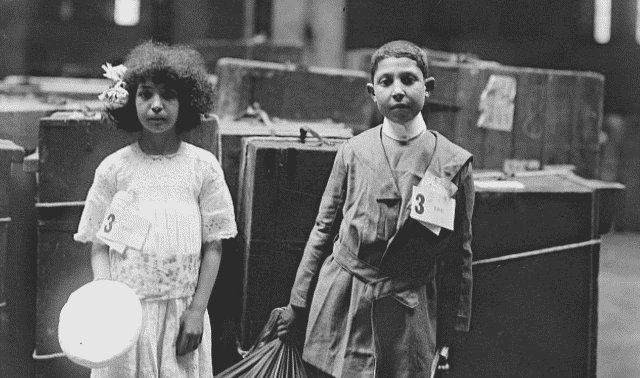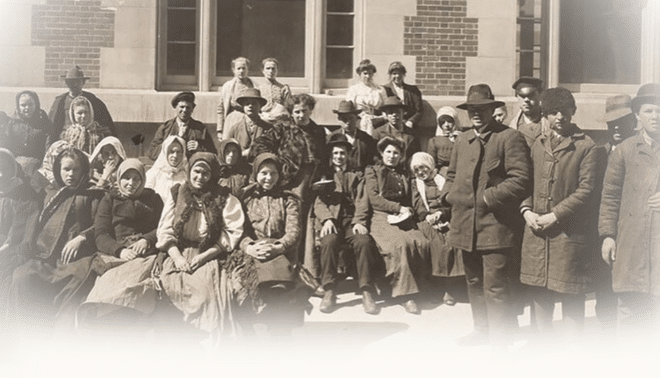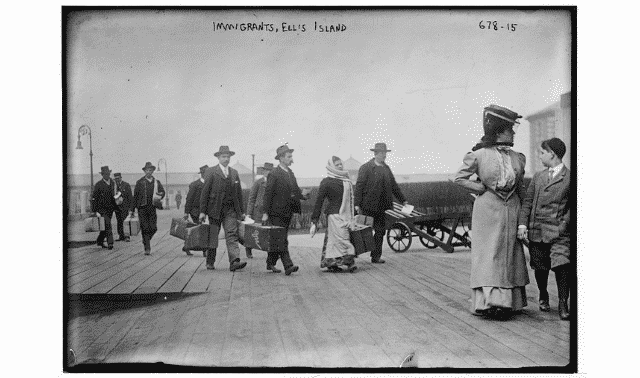Sign up for the Family Tree Newsletter Plus, you’ll receive our 10 Essential Genealogy Research Forms PDF as a special thank you!
Get Your Free Genealogy Forms
"*" indicates required fields

Annie Moore was lucky. Because the 15-year-old Irish girl was the first immigrant to pass through Ellis Island, on Jan. 1, 1892, she was treated more like a celebrity than one of the “huddled masses yearning to breathe free” described on the nearby Statue of Liberty. Fresh off the boat from County Cork, Annie entered America bearing a $10 gold coin from the commissioner of immigration.
The 12 million immigrants who came after her in the next 32 years enjoyed a less red-carpet introduction to America. Herded like animals, probed by doctors, interrogated, tested, sometimes separated from their families and even sent back where they’d come from, the “wretched refuse” of Europe’s teeming shores came to think of Ellis Island as the “island of hope, island of tears.”
But they made it, most of them, following Annie Moore to the promised land and remaking America in their image. Today, more than 100 million Americans have at least one ancestor who came through Ellis Island.
Gauntlet to a new land
For your immigrant ancestors, having their name on a ship’s manifest was the culmination of a dream — and often the beginning of a nightmare. A steerage ticket to America cost about $25, which might be two years’ wages. That bought a crowded, 3,000-mile voyage of two weeks to a month as human cargo, suffering seasickness and unsanitary conditions on a diet of thin soup and bread. Harder still than the voyage was leaving behind everything and everyone you knew Julia Conipow, who emigrated from Lithuania in 1899, remembered, “The day I left home, my mother came with me to the railroad station. When we said goodbye, she said it was just like seeing me go into my casket. I never saw her again.”
But they said their goodbyes and endured the trip to reach, as one British cartoon put it, “the U.S. Ark of Refuge,” where they’d find “free education, free land, free speech, free ballot, free lunch.” They left behind joblessness and poverty, conscription and persecution. Though English, Irish, Germans and Scandinavians had led the migration to America for most of the 19th century, by the time Ellis Island opened in 1892 emigrants from Italy Russia and Austria-Hungary had joined the flood. By 1907, these three groups accounted for 75 percent of the traffic through Ellis Island.
On arrival, first- and second-class passengers were cleared on-board by immigration officials. Steerage passengers were hustled onto a ferry to Ellis Island. At its peak in 1907, Ellis Island handled as many as 11,000 immigrants a day.
Wearing numbered tags that matched a page of the ship’s manifest, the immigrants came up the steps from the pier into the ornate, red-brick and limestone, Beaux Arts main building. First stop was the Baggage Room. Here they could check their meager possessions, a sampling of which can be seen today in Ellis Island’s “Treasures From Home” exhibit: wool gloves from Norway, eyeglasses from Scotland, an apron from Romania, a ladies’ fan from Italy, a battered teddy bear that came to America from Switzerland with Gertrude Schneider, age 10.
From the Baggage Room, the immigrants went up to the Registry Room, the great, two-story main hall with its vaulted, terra-cotta-tiled ceiling and American flags. Even as they mounted the stairs, Public Health Service doctors would be watching for signs of infirmity In what became known as “the six-second physical,” the doctors scanned for ailments that might disqualify a newcomer. A chalk mark on the clothes identified those to be detained for further examination: “H” for heart problems, “L” for lameness, “E” for eye disease — particularly the highly contagious trachoma, which doctors checked for by turning the eyelid inside-out with a buttonhook.
Intelligence was tested, too. A typical question might be, “Would you wash stairs from the top down or from the bottom up?” — which once brought the sharp response, “I didn’t come to America to wash stairs.”
At the far end of the Registry Room waited the legal inspectors. Working with an army of interpreters, they tried to weed out anarchists, polygamists and immigrants unable to support themselves in their new land (“S.I. — L.P.C.,” these were coded: “special inquiry — likely to become a public charge”). About 10 percent of immigrants were held for a hearing; today, visitors to Ellis Island can relive this experience by serving as a mock hearing board, deciding an “immigrant’s” fate in a re-enactment.
According to one of the most often-told tales about Ellis Island, the harried inspectors also changed immigrants’ names, through misspelling or simplification. But Sharon Carmack, author of the forthcoming A Genealogist’s Guide to Discovering Your Ethnic Ancestors (and a contributor to Family Tree Magazine), debunks this legend: “No evidence whatsoever exists to suggest this ever occurred, and I have challenged countless people who insist their ancestor’s name was changed on Ellis Island to provide me with proof. So far, no one has been able to…. Inspectors compared the names the immigrants told them against what was recorded on the passenger lists. These lists were created at the ports of departure. There was no reason to record or change anyone’s surname once they arrived. More likely, immigrants themselves changed their names after they settled in America to avoid prejudice and to blend more easily into American society”
The average stay at Ellis Island was less than a day. Some, however, had to stay overnight in crowded dormitories, or were quarantined in the island’s hospital. Families got separated, and anxious parents might wait weeks to be reunited with their children. More than 3,500 immigrants died on Ellis Island, and more than 350 babies were born.
Ultimately, about two out of every hundred would-be new Americans were turned away. All immigrants’ steamship tickets, in a nice little subsidy for the steamship companies, were required to be for a round trip. A heartbroken handful completed the ticketed journey.
A nation of immigrants
Most who came to Ellis Island, however, went down from the Registry Room to the railroad ticket office and the free ferries to New York and New Jersey, to begin a new life. Immigrants bound for Manhattan met their relatives — many of whom they’d never seen — at the “kissing post.” Katherine Beychok, a Russian Jewish immigrant in 1910, remembered meeting her father for the first time: “I saw a man coming forward and he was so beautiful…. And I fell in love with him and he with me.”
Gaining entrance to America, another immigrant recalled, “was as if God’s great promise had been fulfilled.”
Once beyond the gateway of Ellis Island, though, immigrants found that life could be every bit as hard as it had been back home. An old Italian story posted in today’s Ellis Island museum puts it this way: “I came to America because I heard the streets were paved with gold. When I got here, I found out three things: First, the streets were not paved with gold. Second, they weren’t paved at all. Third, I was expected to pave them.”
But pave them they did — and build our cities and make our laws and enrich our culture. Irving Berlin came through Ellis Island from Russia in 1893; Al Jolson, from Lithuania, in 1894. Knute Rockne arrived from Norway in 1893. Felix Frankfurter came from Austria in 1894, followed by Maria Von Trapp and family in 1938. Sol Hurok came from the Ukraine in 1906. Isaac Asimov came from Russia in 1923.
They gave America their children, too. For example, among the 600,000 names inscribed on Ellis Island’s American Immigrant Wall of Honor are the parents of one Francis Albert Sinatra.
“It touches a human chord in the great spirit of adventure,” says the foundation’s Stephen Briganti, “how these people made it possible for us to be Americans. They are our history”
Immigrants entered through other ports, too — San Francisco, Boston, Baltimore and more. But the greatest influx during the greatest human migration in history came through Ellis Island. In 1903, for instance, 706,113 of the 951,227 immigrants began their American life at the Port of New York. And today, Ellis Island is the only national monument dedicated to the immigrant experience shared by so many of our ancestors.
In 1990, the Ellis Island Immigration Museum opened in the former main building, restored at a cost of nearly $170 million. You can retrace your ancestors’ footsteps and see how Ellis Island and U.S. immigration changed over the years. You can also search through and hear more than 1,700 oral-history interviews of immigrants and former Ellis Island employees.
Soon, as part of The American Family Immigration History Center, you’ll be able to add your own memories and family treasures to Ellis Island. In phase two of the project, the Living Family Archive, visitors (both in person and via Internet) will be invited to contribute scanned copies of family documents, records and photos. These files will be stored for posterity along with the newly computerized ship passenger lists.
It’s all part of discovering and preserving our roots, which for so many of us run through this “island of hope, island of tears.” Like 15-year-old Annie Moore, who’s immortalized in a statue in Ellis Island’s museum, our ancestors sailed under the Statue of Liberty’s lamp and to this “golden door.” Most weren’t as lucky as Annie, and it was a long time before many of them would see a $10 gold piece.
But we’re all lucky that they came.
A version of this article appeared in the January 2000 issue of Family Tree Magazine.
ADVERTISEMENT




